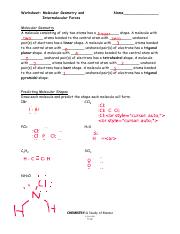Ouille! 34+ Listes de Intro To Intermolecular Forces Pogil Answers? The focus of this lesson:
Intro To Intermolecular Forces Pogil Answers | Intermolecular forces are forces that act between stable molecules or between functional groups of macromolecules. Intermolecular forces, which are weaker but hold separate molecules together. The focus of this lesson: Thirty six asked us to determine the kind of in a molecular forces that are present in each element or compound. Well there's different types of intermolecular forces. What is an intermolecular force? Which of these is not an intermolecular force? Intermolecular forces are the forces. There are three types of intermolecular forces; Thank you for submitting your answer. Molecules do not exist as independent units: Intermolecular forces determine bulk properties such as the melting points of solids and the boiling points of liquids. Worksheet 12a (intro) intermolecular forces predict the type of solids (ionic, molecular, or atomic) the following substances would form: That is the force responsible for holding water molecules together, and. Greater the intermolecular forces, higher is the boiling point. Do not use commas or scientific notation when entering large numbers. (a) kr* (b) ncl3** (c) sih4* (d) hf*** (e) n2* (f) nh3*** (g) co** (h) ccl4* 50. Questions left blank are not counted against you. Page 1 of 7 name date block pogil: Liquids boil when the molecules have enough thermal energy to overcome the intermolecular attractive forces that hold them. These can generally be overcome by physical changes such as temperature. Baxley intermolecular forces worksheet answers are on page 3 & 4. There are three types of intermolecular forces; Strongest force to weakest force. Which of the following is not a kind of intermolecular force? Well there's different types of intermolecular forces. Intermolecular forces are the forces. Molecules do not exist as independent units: (a) kr* (b) ncl3** (c) sih4* (d) hf*** (e) n2* (f) nh3*** (g) co** (h) ccl4* 50. In fact, groups of molecules stick. Different types of intermolecular forces (forces between molecules). Molecules do not exist as independent units: Intramolecular forces occur within/inside molecules, while intermolecular forces occur between molecules. These can generally be overcome by physical changes such as temperature. The intermolecular forces arises due to following interactions: Intermolecular forceschemistryliquids and intermolecular forceswhat's a liquid?intermolecular forcesthe effects of intermolecular forces the molecules in liquids are held together by forces referred to as intermolecular forces. let's take a look at how they work. Intermolecular forces are the forces of attraction or repulsion which act between neighboring particles (atoms, molecules, or ions ). Hydrogen bonding van der waals are the weakest van der waal forces exist between all molecules in the universe. 1 name date block pogil: How much heat is required to melt 42.7 g of diethyl ether? Do the problems on your own before looking at the answers. Intramolecular and intermolecular forces critical thinking questions: Strongest force to weakest force. Intramolecular forces (bonding forces) exist within molecules and influence the chemical properties. Van der waal forces 2. Which of the following is not a kind of intermolecular force? Without intermolecular forces holding molecules together we would not exist. A chapter eleven sexual problem. Page 1 of 7 name date block pogil: H2s i2 n2 h2o 6. There are three types of intermolecular forces; Intermolecular forces are the forces of attraction or repulsion which act between neighboring particles (atoms, molecules, or ions ). Intermolecular forces (imf) are the forces which cause real gases to deviate from ideal gas behavior. The strongest intermolecular force is hydrogen bonding which is the force of attractiong between a h atom which is covalently bonded to the lone pair of one of the strongest intermolecular forces (i.e. Baxley intermolecular forces worksheet answers are on page 3 & 4. The focus of this lesson: The intermolecular forces arises due to following interactions: These can generally be overcome by physical changes such as temperature. Dipoles are stronger than london forces alone, so polar molecules tend to have stronger intermolecular forces than nonpolar molecules of a similar size and polarity.

Intro To Intermolecular Forces Pogil Answers: How much heat is required to melt 42.7 g of diethyl ether?
Refference: Intro To Intermolecular Forces Pogil Answers